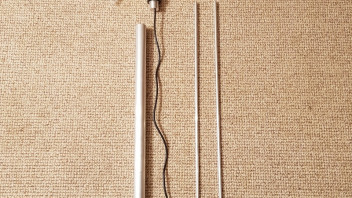Hallo zusammen,
ich bin ja noch eine kleine Antwort schuldig, aber erstmal herzlichen Dank für die verschiedenen Vorschläge und Kommentare...
Am Ende hatte ich mich dann doch für die besagte TA-1 Turnstile Antenne entschieden und noch im November installiert, bevor das Wetter vollkommen unbrauchbar wird.


Die Antenne kommt in ein paar wenigen Einzelteilen und ist ja wirklich schnell aufgebaut. Man sieht da auch meinen 85cm Spiegel mit Rotor für Es'hail-2. Es ist mir ja peinlich, aber nach AO-40 habe ich alle Antennen abgebaut, weil es seitdem für mich nichts vergleichbarers mehr gab, was mich motiviert hätte..  Aber irgendwann kribbelt es dann doch mal wieder. Zumal ich für P4-A / Es'hail-2 sowieso den Spiegel installieren wollte, warum nicht mal wieder klein anfangen.. Auch wollte ich den AirSpy SDR und meinen Funcube Pro+ Dongle (Seriennummer #0000002 !) endlich mal richtig ausprobieren...
Aber irgendwann kribbelt es dann doch mal wieder. Zumal ich für P4-A / Es'hail-2 sowieso den Spiegel installieren wollte, warum nicht mal wieder klein anfangen.. Auch wollte ich den AirSpy SDR und meinen Funcube Pro+ Dongle (Seriennummer #0000002 !) endlich mal richtig ausprobieren...
Ich hatte mich auch deswegen für die TA-1 entschieden, weil ich nach vielen Jahren auch APT-Wettersatelliten empfangen wollte, damals hatte man noch einen "Bildspeicher" als Hardware...hihi
Die Antenne ist sehr breitbandig, was möglicherweise aber auch ein Nachteil sein könnte. Ich habe einen sehr rauscharmen Vorverstärker von SSB Elektronik, der aber vermutlich zuviel Rauschen und Störsignale anderer Frequenznutzer auffängt und deswegen nicht so den deutlichen Effekt bringt, wie ich es früher mit einer Hochgewinn-Antenne gewohnt war. Bei 137 MHz bringt er sowieso nichts mehr. Ich habe in der Nähe sehr starke Nutzer bei 146/147 MHz, da war dann auch der AirSpy teilweise überfordert, auch ohne Vorverstärker.
Aber natürlich interessiert mich der 2m-Satellitenbereich mehr, da wir (AMSAT-DL) möglicherweise noch nächstes Jahr ein weiteres Projekt mit 2m/70cm haben. Da ist es auch von Interesse zu sehen, in welcher Liga die Antenne spielen würde..
Wettersatellitenempfang geht wirklich sehr gut, sehr wenig Rauscheinbrüche. Tatsächlich kann ich auch diverse CubeSat bereits nach dem AOS teilweise sehr stark empfangen. Bei den chinesischen Satelliten ist das Passband-Rauschen nich zu übersehen und die Signale sind echt laut! Der Empfang der FOX-1 (AO-85/91/92/95) geht auch recht gut und und oft sogar rauschfrei.
Um hier einen besseren Eindruck über die tatsächliche Effizienz meiner Empfangsanlage zu bekommen, habe ich kurzerhand den AMSAT Fox-1 Telemetry Decoder "Fox-in-a-Box" auf meinem Raspberry PI3 B+ installiert. Von der Software bin ich wirklich angetan, da haben AC2CZ und andere eine super Open Source Software für die Satellitengemeinschaft bereitgestellt.
Eine tolle Funktion ist auch, dass verschiedene Daten zur eigenen Station auf dem Server gespeichert werden. So zum Beispiel Signal-Rauschabstand, sowohl seitens HF, als auch auf Bitebene nach der Demodulation. Das Ganze läßt sich dann auch grafisch in Abhängigkeit von Azimuth und Elevation des jeweiligen Satelitten darstellen. Mit genügend Überflügen, bekommt man dann ein tatsächliches Bild der eigenen Empfangsanlage, sowohl was das Antennendiagramm angeht, als auch mögliche Abschattungen.


Nebenbei gibt es auch noch eine Statistik über die Anzahl der empfangenen Telemetriepakete und natürlich ein Ranking!
http://www.amsat.org/tlm/leaderboard.php?id=0&db=FOXDB
Immerhin ist es mir gelungen mich bei AO-95 (Fox1-Cliff) auf Platz 8 hochzuarbeiten und mich gegen die "big guns" einigermaßen zu behaupten. Für die anderen Satelliten bin ich zu spät um da noch eine Rolle zu spielen.
Leider geben nur wenige User ihr Equipment vollständig bei FoxTelem an. Aber eine kleine Recherche bei Google hat gezeigt, dass die meisten Big Guns teilweise beinahe EME-Anlagen verwenden. Wenn ich mir dann so meine Ergebnisse ansehe, dann scheint die TA-1 eigentlich überdurchschnittlich zu funktionieren. Echte direkte Vergleichsdaten fehlen mir, vielleicht würde eine Eggbeater oder so ja tatsächlich noch besser funktionieren.. wer weiß. Vielleicht probiere ich das nächstes Jahr mal aus..
Ich beobachte bei den Fox-Satelliten teilweise ein starkes und tiefes Fading, vermute aber es liegt jeweils an der Satellitenorientierung.
Noch habe ich nicht genügend Samples von den Überflügen sammeln können, aber in ein paar Monaten ergibt sich vielleicht ein deutlicheres Bild..
Ich hoffe ich konnte einigen Lesern ein paar Anregungen geben. Natürlich ist eine Richtantenne mit Rotor das "Non plus ultra".. aber zum "Reinhören" gehts auch mit einem optimierten Rundstrahler..
73s Peter
![]()

